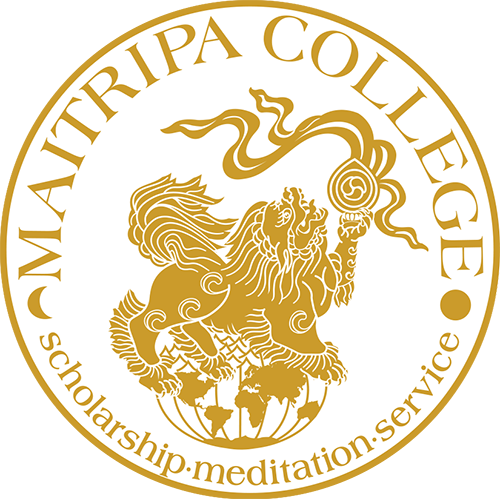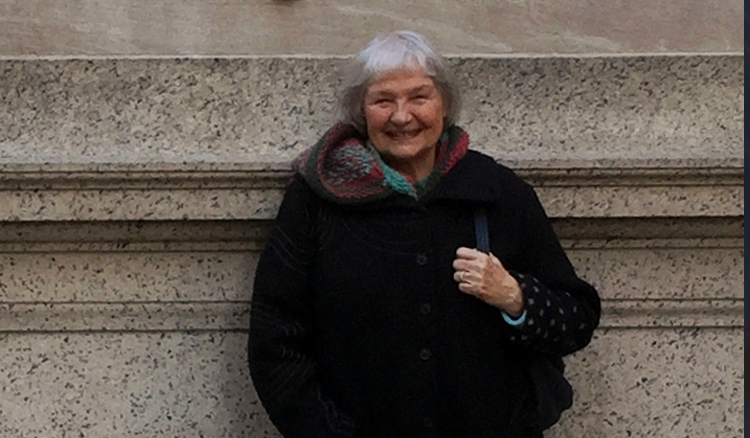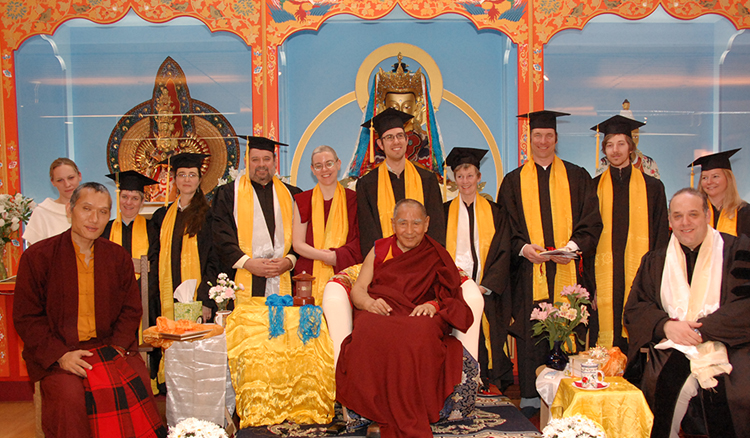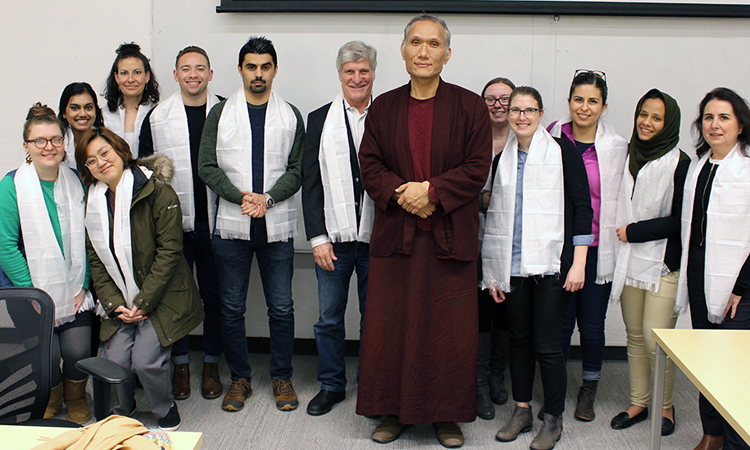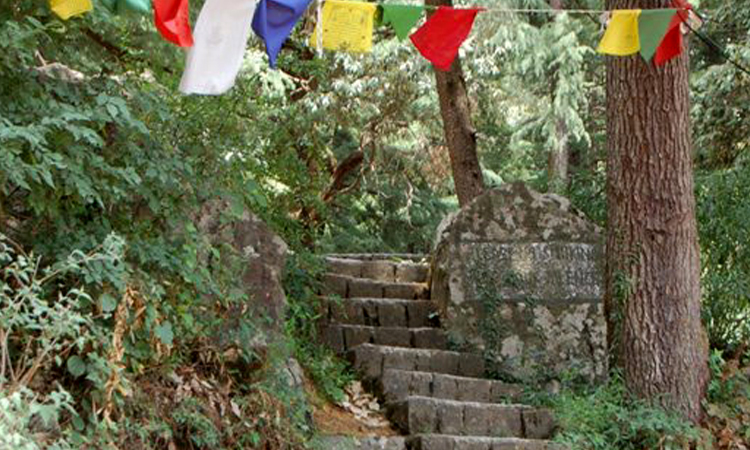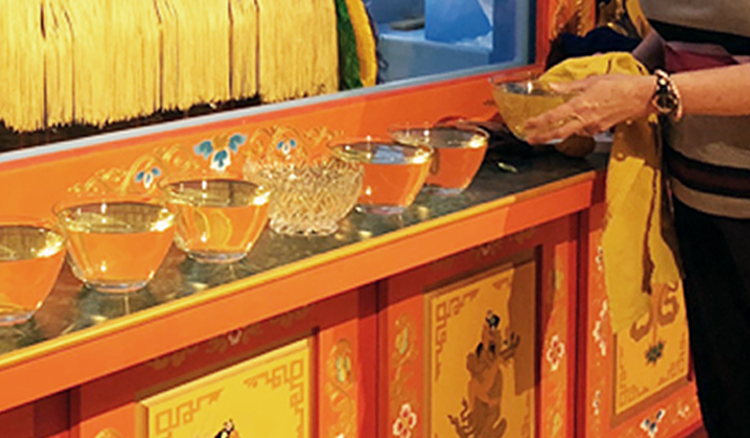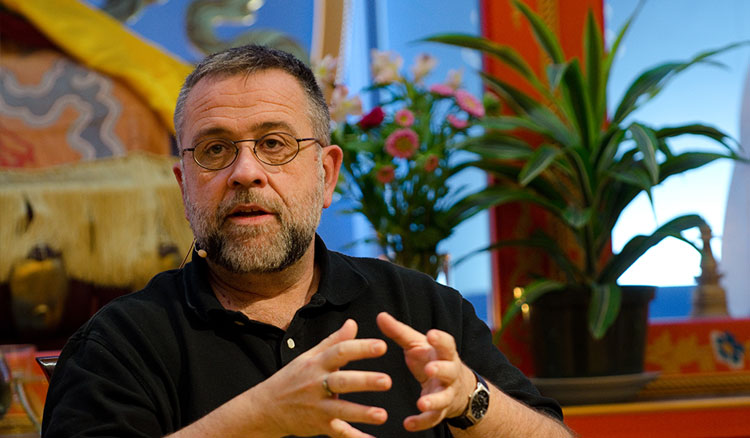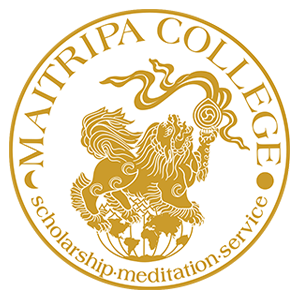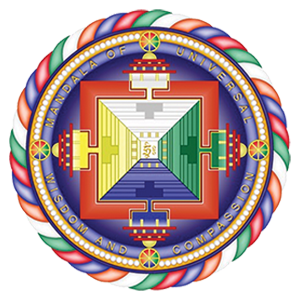In Honor of the 86th Birthday of His Holiness the 14th Dalai Lama of Tibet
(Lapis Post: July 6, 2021)
In honor of the 86th birthday of the embodiment of compassion in human form, His Holiness the 14th Dalai Lama of Tibet, in this Lapis post the core faculty of Maitripa College offer stories of moments with His Holiness from their own experience. We rejoice in our fortune to be alive at this precious time, we dedicate our positive actions to the fulfillment of the good works of His Holiness, and we pray for his continued health, happiness, and long life.
Yangsi Rinpoche: No Choice But Truth
I grew up with a great amount of blessing, guidance, and teachings from His Holiness. My generation of Tibetan scholars is greatly influenced by him, his philosophical view, and his conventional worldview…it really impacted and shaped the dreams of my generation. And also, of course, really inspired us.
I met His Holiness for the first time in the early 1980’s, I think 1981 or 1982. His Holiness was giving a one-month oral transmission of the 8,000 volume Perfection of Wisdom Sutra in South India. At that time myself and my teacher had my first private audience with His Holiness. And then over the years I had many others.
Later on, in the late 80’s or early 90’s, I went to an interview with His Holiness with my teacher, who is now the current Ganden Tri Rinpoche, though at that time I think he was Abbot of Gyume Tantric College. My teacher and His Holiness are the same age, born the same year. So in that audience at one point His Holiness looked at me directly and asked me, “Who looks younger? Me or him?” referring to my teacher.
What was I going to do?
I looked straight up into his face, and then I looked into my teacher’s face, and at that moment my teacher looked a bit younger. So what was I going to do? I couldn’t lie. I couldn’t be politically correct. So I told the truth, and I said my teacher looked younger.
Something like that.
We are all really fortunate to be living in a time and a place in which we have such a great spiritual leader, and to be able to receive teachings and guidance from him. I dedicate my merits to the long life of His Holiness.
Dr. Bill Magee: A Sweet Story
When His Holiness the Dalai Lama came to North America in the 1980’s, he sometimes stayed at the Tibetan Buddhist Learning Center in Washington, New Jersey. On one of those occasions I brought my mother to see him.
My mother suffered from arthritis and deep fear of crowds, so it was quite remarkable that she would even consider attending an all-day event with thousands of strangers. I did not expect her to go, but she did.
Our friend Plunkett brought along a kitchen chair and walked behind her all day in case she needed to sit down, which she did frequently. Afterwards a line formed to greet the Dalai Lama. When we reached the front of the line I offered a khatag and introduced my mother. He took her hands and gently bumped her forehead. Then he turned to me and said, “Where did you study Tibetan?”
I told His Holiness that I studied with Geshe Thardo and Jeffrey Hopkins. Thousands waited in line behind us. The Dalai Lama’s bodyguards knew what to do: they gripped me by the elbows. They lifted me up and we all moved to the left. But the khatag, snagged on a button, floated free like a white banner.
The men dropped me and leaped forward to prevent it touching the ground. Plunkett joined the melee carrying the kitchen chair. But my mother did not need to sit down. It was, she told me later, the happiest moment of her life.
Dr. Leigh Miller: The Miracle of Embodied Compassion
Every year, His Holiness the Dalai Lama makes a statement, which then gets circulated across social media, about what He wants for his birthday. You may be wondering what that could be, as when our teachers are about to reveal the best offering we can make them. Raspberries on chocolate cake? No, maybe mango sorbet. Or, financial donations to their favorite projects?
These are lovely and appreciated, but of course are not what brings them real happiness and joy. What can do that? Our happiness and joy. The kind that results from practicing Dharma. Our best offering, our teachers say, is our practice, and for His Holiness the Dalai Lama, who is said to be the emanation of Chenrezig, Avalokiteshvara, and earthly embodiment of the perfection of boundless compassion, that practice is specifically to be kind to everyone, think of others first, and try with unwavering perseverance to reduce harm and suffering in this world.
Before meeting His Holiness the Dalai Lama in person, I’d have thought that this sounded nice, but it would have rung hollow inside me, like a Hallmark card, devoid of both pragmaticism and heartfelt conviction.
How many people are really going to do that, and even if some of us do, would it really make any difference? Can any human really be completely altruistic, all the time, in any situation?
When I met his Holiness, I was in college, seeking an answer to why we suffer and what to do about it and maybe even how to nurture thriving in others through psychology and philosophy classes, but finding only pathologies and hypothetical ideals. Them I met His Holiness for the first time.
His Holiness walked onto a stage and hundreds of people silently rose to their feet, sat rapt listening to him explain our universal responsibility to bring about the wellbeing of others, and then laughed, cried, and hugged each other after he departed. I’d never even imagined the potential impact of such palpable compassion, wisdom, equanimity, love, and joy. It rearranged me from the inside, seemingly on a molecular level.
Later, I would see His Holiness cry when meeting refugees escaped from Tibet and when teaching Shantideva’s classic text, amazed that each individual person, each recitation, though repeated countless times over decades of his lifetime, never diminished but ever strengthened his wish and activities to end the suffering of beings. He has said repeatedly if he learned anything about compassion, it is from his mother, and from Shantideva; reassurance that compassion is learned by example, from everyday loving-kindness, through diligent training in the six perfections, and through rigorous generation of profound insight into the nature of reality.
His Holiness is alive and walking on this earth at this time. The personal miracle of this fact is that I have glimpsed the practical and philosophic wisdom of emptiness and felt the warmth of limitless compassion in my heart, merely by being in his presence.
I need the living example of perfect compassion, physically present in my life, to develop complete faith that it is possible, and to inspire my aspirations, sustain my commitments. Now, whenever I want, I can clearly recall His Holiness’ face and feel the smooth gentle touch of his lotus petal hand on my cheek, his eyes gazing upon me with immensely empowering love. Love so strong it more than once anchored me where I stood, shook me to sobs, and burst me open to awe. Most days, I meet the lama in my heart, visualizing his face alighting before me for a moment, always smiling, and I softly smile in return. Maybe it has carved a neural network, like a visible path worn through tall grasses, or it’s the blessings of the gurus and buddhas, but that gaze of love never dims from my mind’s eye and never fails to connect me to my better self, a bigger perspective, empathy, an altruistic intention. Actions that follow from there, I know, are always better than they might have been otherwise. If I have any idea of how to practice compassion, it is due to the kindness of His Holiness the Dalai Lama, and my teachers who have been trained by him. I offer them my practice on this day.
May His Holiness, and all true lamas everywhere, have long, long lives, healthy and stable, and their every wish be swiftly and completely fulfilled.
Dr. Namdrol Miranda Adams: Finding Home
It was the late 1990’s, when I was first getting involved in Tibetan Buddhism, on the last day of a series of teachings on the Perfection of Wisdom Sutra that culminated in a refuge ceremony with His Holiness in New York City. At the end of the teachings, the venue was emptying, and I was leaving the place with my mom (with whom I had attended the teachings and, sweetly, took refuge alongside). We were among the last to leave the Roseland, a midtown Manhattan concert venue where the event had been held. As we trailed along outside, there was a palpable and mixed sense of both fullness and emptiness: fullness and contentment from a series of profound teachings and blessings, and the deflation that comes when such an event is over.
As we were walking away, I turned my head, and out of the corner of my eye caught a glimpse of a flash of red. I stopped and turned completely, and just across the street from me, from a nondescript door in the side of the Roseland, I saw a trail of red-robed figures. It was the entourage of His Holiness, six to eight Tibetan monks, heading outside. A moment later there was a visceral pause and intake of breath, and then, as I stood there, His Holiness himself came out, moving swiftly towards the open door of a black sedan parked on the street. In front of him and on each side were large men in dark suits wearing earpieces and eyeing the street with suspicion.
As I stood there, His Holiness stopped for a moment, looked directly at me, and smiled. When his eyes met mine I felt as if my entire body had turned into golden light. I was completely paralyzed. In retrospect, I realized I had literally been standing in the middle of the sidewalk, gaping at him like a fish out of water, too thunderstruck to even nod my head or fold my hands in a traditional sign of respect. And then, before I could even take a breath, he was on the move again, bustled into the back of the waiting car, and gone.
As the car pulled away I began to cry, and was overcome by the intense and unmistakable feeling that I was being left behind; I desperately wanted to follow him. The pain of being separated from him was visceral, and I stood on the street in tears.
Of course I did not follow him, and moments later, the spell was broken, the street was empty, and I took a step forward and was transported back to my life in New York City. However, the palpable feeling of finding home in that moment, and being separated from it, took hours to diffuse.
In the years that followed, I have thought of this experience often, usually with some combination of wonder, curiosity, and skepticism. Happily, since then, I have met His Holiness many times, and am always reminded of that first meeting. Part of my prayers since that day have been a version of the traditional verse from Lama Tsongkhapa’s Foundation of All Good Qualities:
In all my lives, never separated from perfect teachers
May I enjoy the magnificent Dharma
And, by completing the qualities of the grounds and paths,
May I quickly attain the state of Vajradhara.

(The Mantra of Chenrezig, the Buddha of Compassion)
